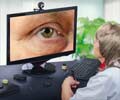Aydogan Ozcan, a UCLA engineer, has created a miniature microscope, the world's smallest and lightest for telemedicine applications.
Aydogan Ozcan, a UCLA engineer, has created a miniature microscope, the world's smallest and lightest for telemedicine applications.
The microscope builds on imaging technology known as LUCAS (Lensless Ultra-wide-field Cell Monitoring Array platform based on Shadow imaging), which was developed by Ozcan.Instead of using a lens to magnify objects, LUCAS generates holographic images of microparticles or cells by employing a light-emitting diode to illuminate the objects and a digital sensor array to capture their images.
The technology can be used to image blood samples or other fluids, even in Third World countries.
"This is a very capable and yet cost-effective microscope, shrunk into a very small package. Our goal with this project was to develop a device that can be used to improve health outcomes in resource-limited settings," Ozcan said.
The lensless microscope, in addition to being far more compact and lightweight than conventional microscopes, also obviates the need for trained technicians to analyze the images produced ? images are analyzed by computer so that results are available instantaneously.
Weighing 46 grams ? approximately as much as a large egg ? the microscope is a self-contained imaging device. The only external attachments necessary are a USB connection to a smart-phone, PDA or computer, which supplies the microscope with power and allows images to be uploaded for conversion into results and then sent to a hospital.
The technology has the potential to help monitor diseases like malaria, HIV and tuberculosis in areas where there are great distances between people in need of health care and the facilities capable of providing it, Ozcan said.
DIC microscopes are used to gain information on the density of a sample, giving the appearance of a 3-D image by putting lines and edges in stark contrast..
The new invention has been described online in the journal Lab on a Chip.
Source-ANI
SRM
 MEDINDIA
MEDINDIA


 Email
Email








